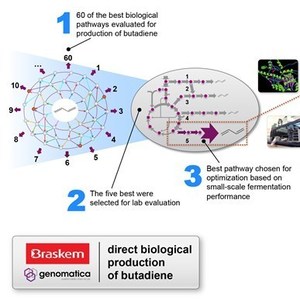Genomatica, Braskem produce biobased butadiene at lab scale




Genomatica
November 23, 2015
BY Genomatica
Genomatica and Braskem announced they have been successfully producing butadiene at lab scale since June 2015, using their direct, biobased process. The companies are jointly developing a commercial process for the on-purpose production of butadiene made from renewable feedstocks, as announced in December 2013.
Butadiene is a raw material used in the production of rubber for tires, as well as for electrical appliances, footwear, plastics, asphalt, building materials, and latex. The demand for butadiene is over 20 billion pounds per year worldwide, and growing. By producing a renewable butadiene, the everyday products made with it, like tires, can become more sustainable, with a smaller environmental footprint.
Program results include:
Advertisement
1) Direct, continuous production: The program team has successfully developed a microorganism that consumes sugar and converts it to butadiene at lab scale, in 2-liter fermenters. Butadiene has been produced, collected and measured continuously, over the course of multiple days for each fermentation.
2) Development of multiple direct pathways and novel enzymes: To develop an optimal process, Genomatica used its computational tools to figure out every possible way that a microorganism could theoretically make butadiene, and identified 60 potential biological pathways. The five best were selected for experimental validation, conducted by Genomatica and Braskem teams in San Diego and Campinas, along with full-time visiting scientists from Braskem at Genomatica's Innovation Center. The team explored a large number of enzyme candidates, applying environmental sampling and metagenomics, for each step in the potential pathways. Genomatica then multiplied enzyme activity 60-fold on non-native substrates using its high-throughput screening and enzyme engineering capabilities.
3) More intellectual property: The program team has significantly added to the extensive intellectual property that Braskem and Genomatica have in this field. This work speaks to design of optimal microorganisms and processes; supports subsequent development stages; and represents an important competitive advantage.
"Our joint team has made good use of Genomatica's integrated bioengineering platform, including its computational techniques and high-throughput cloning and screening, to quickly hit a key milestone," said Nelson Barton, senior vice president of research and development at Genomatica. "Our 'rational' approach to strain design should enable faster, more predictable scale-up and better economics as we advance the program."
Advertisement
"We're delighted to share this strong technical progress," said Patrick Teyssonneyre, innovation and technology director at Braskem. "This sets a foundation for an important new process for the industry. The work we are doing with Genomatica is another example of the success of our open innovation system, which aims to provide our customers with competitive advantages in their businesses. We believe that renewable chemistry is an important part of their future and ours."
From its origin, in 2002, Braskem invests in technological processes that result in greater efficiency and sustainability of its products. In addition to the project with Genomatica, Braskem has been producing polyethylene from ethanol since 2010, labeled as 'I'm green, and has another cooperative agreement with partners to develop green isoprene.
Related Stories
The U.S. Department of Energy Bioenergy Technologies Office (BETO) announced up to $23 million in funding to support research and development (R&D) of domestic chemicals and fuels from biomass and waste resources.
The U.S. DOE has announced its intent to issue funding to support high-impact research and development (R&D) projects in two priority areas: sustainable propane and renewable chemicals and algal system cultivation and preprocessing.
Sens. Sherrod Brown, D-Ohio, and Pete Ricketts, R-Neb., in August introduced the Renewable Chemicals Act, a bill that aims to create a tax credit to support the production of biobased chemicals.
The Chemical Catalysis for Bioenergy Consortium, a consortium of the U.S. DOE’s Bioenergy Technologies Office, has launched an effort that aims to gather community input on the development of new biomass processing facilities.
USDA on March 8 celebrated the second annual National Biobased Products Day, a celebration to raise public awareness of biobased products, their benefits and their contributions to the U.S. economy and rural communities.
Upcoming Events










